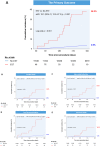High platelet reactivity strongly predicts early stent thrombosis in patients with drug-eluting stent implantation
- PMID: 38177178
- PMCID: PMC10766995
- DOI: 10.1038/s41598-023-50920-9
High platelet reactivity strongly predicts early stent thrombosis in patients with drug-eluting stent implantation
Abstract
Stent thrombosis (ST) is a fatal complication after percutaneous coronary intervention (PCI). The association between P2Y12 reaction unit (PRU) level and stent thrombosis occurrence remains unclear. Based on the multicenter, observational PTRG-DES (Platelet function and genoType-Related long-term proGnosis in DES-treated patients) registry of patients with drug-eluting stents (DES) implantation, a total of 11,714 patients with PRU values were analyzed. We sought to identify the predictors of early stent thrombosis (EST) and compared the primary outcome, a composite of cardiac death, myocardial infarction, and revascularization, between EST and non-EST groups. EST, defined as definite ST within 1 month after index PCI, occurred in 51 patients. PRU values were significantly higher in the EST group (263.5 ± 70.8 vs. 217.5 ± 78.7, p < 0.001). In multivariable analysis, PRU ≥ 252 (OR, 5.10; 95% CI 1.58-16.46; p = 0.006) and aspirin reaction unit ≥ 414 (OR 4.85; 95% CI 1.07-21.97; p = 0.040) were independent predictors of EST. The cumulative incidence of primary composite outcome at one year was significantly higher in the EST group (38.2% vs. 3.9%, Log-rank p < 0.001). In patients treated with clopidogrel after successful DES implantation, EST was associated with higher platelet reactivities, and a greater risk of cardiovascular events.Trial Registration: clinicaltrials.gov Identifier: NCT04734028.
© 2024. The Author(s).
Conflict of interest statement
The authors declare no competing interests.
Figures
References
MeSH terms
Substances
Associated data
LinkOut - more resources
Full Text Sources
Medical
Research Materials
Miscellaneous




